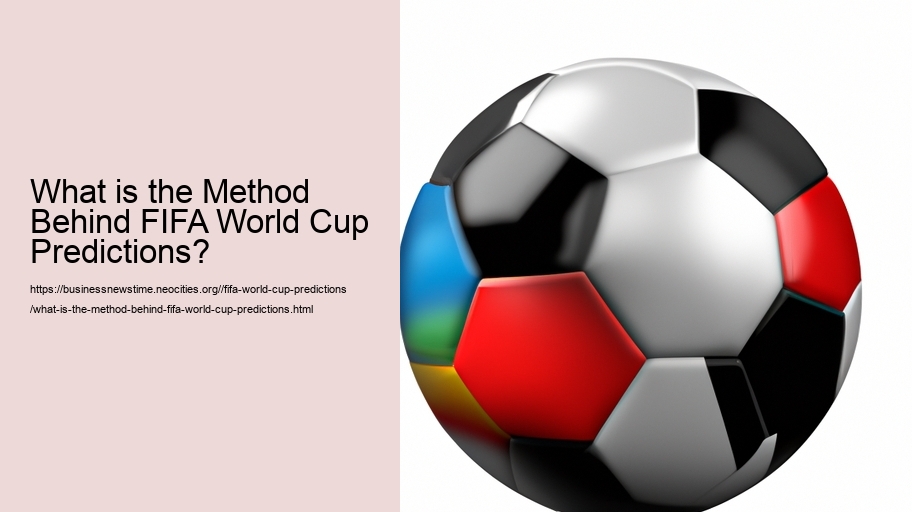### What is the Method Behind FIFA World Cup Predictions?
Find out more about FIFA World Cup Predictions here..
The FIFA World Cup stands as one of the most anticipated sporting events globally, drawing immense attention from fans, analysts, and bettors alike. With its quadrennial occurrence, this tournament galvanizes millions to predict outcomes with a fervor seen in few other sports spectacles. But what underpins these predictions? The methods behind FIFA World Cup predictions are diverse and multifaceted, blending statistical analysis, historical data, team dynamics, player performance metrics, and even psychological factors.
#### Statistical Analysis
One of the primary tools used in predicting World Cup outcomes is statistical analysis. This involves crunching numbers related to past performances of teams and players. Analysts look at win-loss records, goal differentials, defensive capabilities, and offensive prowess. Advanced metrics such as Expected Goals (xG), Passing Accuracy Percentage (PAP), and Player Efficiency Ratings (PER) provide deeper insights beyond traditional statistics.
For instance, xG calculates the probability of a goal being scored from a particular position on the field based on historical data of similar shots. By aggregating these probabilities over multiple matches or tournaments, analysts can form a more nuanced view of a team's scoring potential versus their opponents' defensive strengths.
#### Historical Data
Historical performance plays an essential role in shaping predictive models for the World Cup. Teams like Brazil and Germany often garner high expectations due to their storied success in previous tournaments. By analyzing patterns over decades-such as how well certain nations perform under specific conditions or against particular rivals-analysts can make educated guesses about future outcomes.
Historical data also includes head-to-head matchups between teams. Some nations have psychological edges over others due to consistent victories in past encounters. These intangibles can be pivotal when two evenly matched teams face off.
#### Team Dynamics
Beyond numbers lies the human element: team dynamics significantly impact predictions. Analysts scrutinize coaching strategies, formation setups, and player roles within a squad. A coach with a reputation for tactical ingenuity might tilt predictions favorably towards his team.
Injuries play an equally critical role; the absence of key players can dramatically alter expectations. Conversely, the emergence of young talents or effective mid-season transfers can boost a team's prospects unexpectedly.
Team chemistry is another subtle yet potent factor in predicting outcomes. Cohesion among players often translates into superior teamwork on the pitch-a vital attribute during high-stakes matches where individual brilliance may not suffice alone.
#### Player Performance Metrics
Individual player performance also contributes heavily to prediction models. Metrics such as goals scored per game (for forwards), tackles made per game (for defenders), save percentages (for goalkeepers), among others help form comprehensive profiles for each player's contributions.
Modern technology enables real-time tracking of numerous variables: distance covered during games by each player indicates stamina levels; heat maps show preferred zones where they operate efficiently; speed metrics highlight who might outpace whom during crucial moments-all feeding into robust predictive frameworks.
#### Psychological Factors
While harder to quantify than raw data points or physical statsheets are psychological aspects influencing both individual players' performances & overall team morale throughout tournaments phases right up till final stages itself! Pressure handling abilities vary widely amongst individuals-some thrive under spotlight while others falter miserably despite possessing technical skills required succeed otherwise!
Moreover crowd support cannot overlooked either – hosting country typically enjoys significant advantage courtesy home crowd cheering them onwards relentlessly every step way although sometimes excessive expectations prove counterproductive instead leading heightened stress levels ultimately detrimental rather beneficial long run course competition itself…
#### Computer Simulations & Machine Learning Models
Recent years witnessed surge application machine learning algorithms artificial intelligence domain sports analytics too wherein sophisticated computer simulations run thousands times incorporating myriad variables discussed earlier generate probabilistic forecasts likely scenarios unfolding forthcoming matches themselves! These models continuously refined incorporating latest developments injuries transfers tactical shifts etc ensuring highest possible accuracy attainable given available information dataset involved…
### Conclusion:
In conclusion method behind FIFA World Cup predictions amalgamation various techniques ranging traditional statistical analyses advanced machine-learning methodologies encompassing everything intermediate including historical trends team dynamics individual player assessments psychological influences collectively striving achieve most accurate realistic foresight upcoming tournament results possible… While no single approach guarantees infallible predictions multiplicity perspectives combined indeed offers best chance understanding anticipating beautiful game's greatest spectacle world stage!
